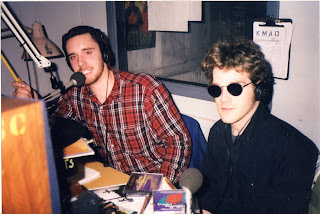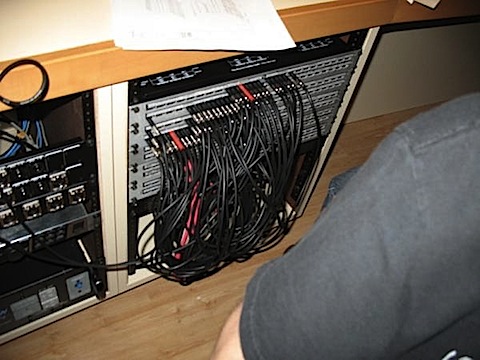Hard to believe it’s
been 14 years since the FCC shut down KMAD, the pirate FM radio station
built and run by myself and a handful of intrepid Media Arts students. Hard to
believe because it feels more like 28 years. ; )
One of the station’s staff members, Jerry Recco, currently of
WFAN fame, was a music DJ on our little pirate enterprise. Jerry will be
speaking to my Radio Production class April 30, and we intend to do a field
trip to his station.
 |
| Homebrew stacked colinear array |
The old Media Arts Building on West Side Avenue was razed
shortly after we vacated to Fries Hall… but I have preserved one of KMAD’s on-air
consoles (look in the dub room), some of the transmitter and a portion of the
antenna (both home-brew.)
On the day of the “shut down,” an FCC agent from the Manhattan
office easily homed-in on KMAD’s stereo FM signal. We had been incrementally
improving our signal quality and strength. A big part of the station’s generous
coverage pattern came from the antenna, a stacked co-linear array (see pic, above left) which was designed and built by airstaff-member Sue Boehning and myself, and erected
by the entire station staff. Following that, we never looked back.
On the infamous day of reckoning, Chris Halverson, General
Manager of KMAD, called me at my home shortly after the FCC agent arrived. Though
we knew our illegal station would have a limited life and were fully prepared
for a “site-visit” by the Federales, it was nonetheless an emotional day.
The concept of KMAD is alive today as we pursue live
streaming.
Check out some pics of the staff/station below. There’s also
a scan of an actual log sheet and posted rules. Good times.
 |
| Stars of citizen-owned air. See log in background. |
 |
| Some of the staff. |
 |
| We had 2 Control Rooms available for air. This was used for "bigger" shows. |
 |
| Christian Morelli worked in a record store, and he used it as his music library. |
 |
| Prof. and Sue B., the antenna builders. |
 |
| In storage, some of the transmitting gear I made. |
 |
| KMAD GM Chris Halverson at the top secret transmitter location. |
Back to KMADradio blog


















